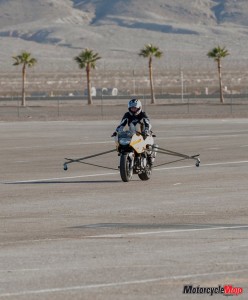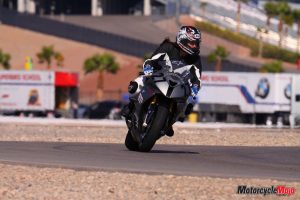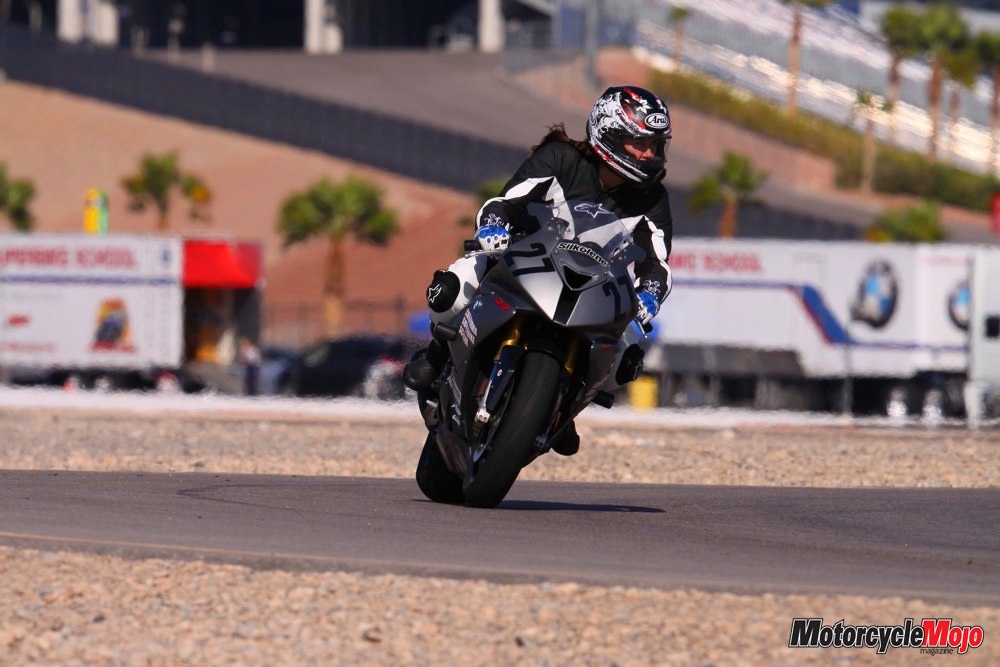After a harrowing crash, author Marissa Baecker realized that the only way to regain her peace was to mentally and physically advance her riding skills
I have lost track of how many times over the years I have heard someone say, “There’s two kinds of riders; those that have been down and those that are going to go down.”
I have brushed it off as negativity and maintained a positive attitude each and every time I get on the bike. However, last year, I guess my number was up and I joined the cliché. I went down.
 Parting with my bike in California was an extremely dramatic experience, although physically I managed to walk away fairly unscathed. My injuries were resolved with medical attention followed by some time off from riding. When it was all said and done, my medical bills came in at a whopping $154,000 USD. Fortunately, I had travel insurance to cover those costs.
Parting with my bike in California was an extremely dramatic experience, although physically I managed to walk away fairly unscathed. My injuries were resolved with medical attention followed by some time off from riding. When it was all said and done, my medical bills came in at a whopping $154,000 USD. Fortunately, I had travel insurance to cover those costs.
Riding is my peace. When I put my helmet on, the chaotic world that surrounds my everyday life goes quiet. No cell phones, no radio, no computer and no demands. Nothing but a teasing of my senses as the wind flows beneath my visor. It is as though I unplug.
Upon returning to the saddle, I realized I hadn’t entirely healed. In fact, there were further, invisible injuries in the form of emotional and mental trauma, and my post-accident jitters were impairing my ability to fully enjoy riding.
Great. Now what? Do I just keep riding and hope the jitters go away, or do I retrain and look to polish and advance my skills as a rider?
 Disappointed to have my peace stolen from me, and knowing that it was going to take something much stronger than determination to regain my confidence, I chose to retrain and advance my skills. It was tough to find an advanced riding school, as Canada doesn’t always offer the weather or the track facilities to accommodate its own widespread riding population.
Disappointed to have my peace stolen from me, and knowing that it was going to take something much stronger than determination to regain my confidence, I chose to retrain and advance my skills. It was tough to find an advanced riding school, as Canada doesn’t always offer the weather or the track facilities to accommodate its own widespread riding population.
As the Canadian riding season was wrapping up, I began searching stateside for a program that could meet my needs. A look through the many websites of tracks and instructional programs eventually led me to the California Superbike School. A statement on their website (superbikeschool.com) read, “For decades, expert riders have proclaimed riding to be 90% mental.” There it was in black and white – and I was off to Vegas to learn specific, high-speed braking and cornering at the Las Vegas Motor Speedway with some of the best international race coaches available.
These guys train professional moto athletes, and have married art with science to a point where every motorcyclist, no matter what they ride, can benefit. As I walked toward more than thirty 2013 BMW S1000RR motorcycles, all lined up, shining in the morning desert sun, my stomach sank. I was scared.
The sensation intensified as I scanned the sea of riding enthusiasts mingling over breakfast in front of two, decked-out 18-wheelers, swapping riding stories like they had all been lifelong friends, and all with one vision in mind – speed.
It is amazing how small the world becomes when its international inhabitants converge on one location to share the same passion. Brazilian and French accents mixed with that southern U.S. drawl and the distinct sound of Canada.
Of the 30 students in attendance, eight were Canadian, four, including me, from British Columbia, and the youngest, a 15-year-old motocross racer in attendance with his father from Montreal. Our gathering would be split into four separate groups – levels I though IV – and most riders were here for two days, completing one level each day. My Level I course consisted of 16 riders; 15 men, and me, the lone gal, a situation I find myself in more often than not. As intimidating as it was to be on the track with testosterone-driven speed demons, I was assured I had come to the right “doctors” to cure my problem.
 The rules of the track are clearly laid out. There are no speed restrictions, but you may not race one another. As students, we were required to pay attention to our own riding and our own improvement. A six-foot buffer is required between riders, which includes passing, and there are several coaches on the track at any given time to enforce this rule and to park you if you break it. As it is a track, full leathers and protective gear are non-negotiable.
The rules of the track are clearly laid out. There are no speed restrictions, but you may not race one another. As students, we were required to pay attention to our own riding and our own improvement. A six-foot buffer is required between riders, which includes passing, and there are several coaches on the track at any given time to enforce this rule and to park you if you break it. As it is a track, full leathers and protective gear are non-negotiable.
The plan: learn the skill, and the speed will follow. Prior to each track session, we had classroom drill instruction. The classroom and track sessions alternated between the groups, so that only one group was on the track at a time.
During my first morning session, I struggled with accident imagery and concentration – the whole reason I went there. Our first drill on the track was about throttle control, and we were required to ride only in fourth gear with no brakes. Did I mention that this was fourth gear on a BMW S1000RR? No sweat (or should I say, I was sweating!).
During my last one-on-one with chief riding coach Cobie Fair, it hit me – the realization that my accident may have had a different outcome if I’d attended this course long ago. In all my years of riding, without knowing it, I lacked essential tools that may have allowed me to correct a slide, tighten a wide turn and brake with control in gravel. That was tough to accept.
As I walked the grounds with Keith Code, the founder of the school, we talked and he told me something that is difficult for a rider to hear: “It’s always our fault.” He wasn’t being critical; instead, he implied that it is the riders’ responsibility to keep learning, refine our skills and ride within our limits. If we don’t do these things, and we have an accident, who is really to blame? Recalling my accident, I ran over several scenarios to try and contradict his statement, but in each one, I could apply one of my newly learned skills that could have changed the outcome. It all came down to riders’ reactions to each situation, and their ability to apply their skills and expertise at the moment they are needed.
As the sun began setting on day one, I crossed over to a stronger mental state, and accident flashbacks subsided. We had covered steering, throttle control, turn points, apex, corner exits, quick turns and more. The resulting increase in speed and control translated to confidence.
During day two’s morning stroll past the BMW fleet, I was packing attitude. I mentally reviewed each corner in my mind as we all gathered enthusiastically for another day. We were congratulated on completing the level of the previous day and then told that today, we would be riding the track in the opposite direction. This announcement changed the game completely and shook my newfound confidence. All of the angles, banks, and entrance and exit points would be completely different. I wasn’t alone in my trepidation, as the whole room chattered upon this announcement.
Today, we would be building on the skills learned the previous day. Individual riders would be selected for various off-track improvements. Those ready for more speed would be offered specialized equipment to help them develop their skills.
I began with the “braking bike,” which allowed students to push the limits of braking without the concern of crashing if the front brake locked up.
“I am pulling as hard as I can,” I muttered from my helmet. “I can’t do it.”
“Then what are you afraid of?” said my instructor.
He had a point. I was afraid to use my brakes, because I was afraid to go down (again), but after I pulled on the brake lever as hard as I could and I didn’t lock up the front tire, I returned to the track, ready to try it out for real.
The second learning tool was the “lean bike.” Its design allows riders to feel the sensation of the bike tipping into a high-speed corner without worrying about going down.
Each rider would also take to the track on the video bike and have their riding analyzed each day. In my case, day one showed my nervousness by the movement of my helmet. I was constantly scanning for hazards, but the following day showed a more stable and confident ride.
By the end of my last track session, I was cornering twice as fast. I may not have been the quickest rider, but I was still beaming with pride. In fact, after one particular track session, one of the men came up to me and said, “I can’t believe the way you passed me on that last lap – good going.” I smiled and nodded and completely took credit for the comment, even though I knew he was talking about the gal in the level ahead of me. I passed no one. I don’t care. I didn’t go there to pass or to be the fastest rider, and I learned that it is much more difficult to drag a knee than I originally suspected.
I went to regain my confidence, and I put my trust in my coach and in the school in order to get my peace back. I definitely got what I went for.
The trouble is, now I want more. The 2014 schedule has been released, and levels III and IV are calling.




















